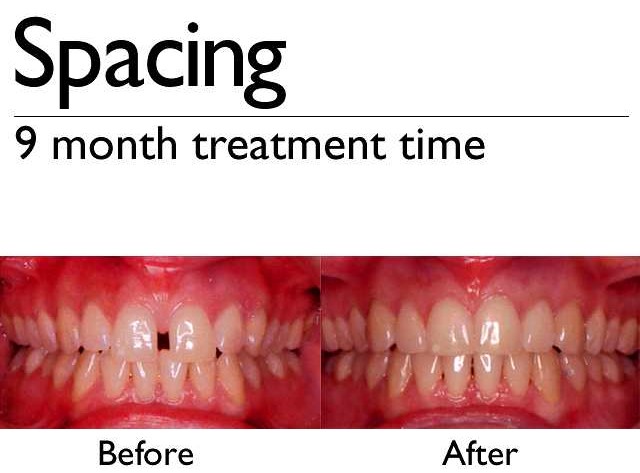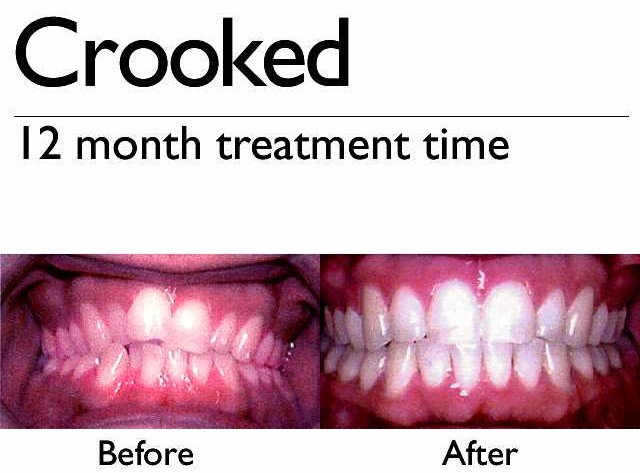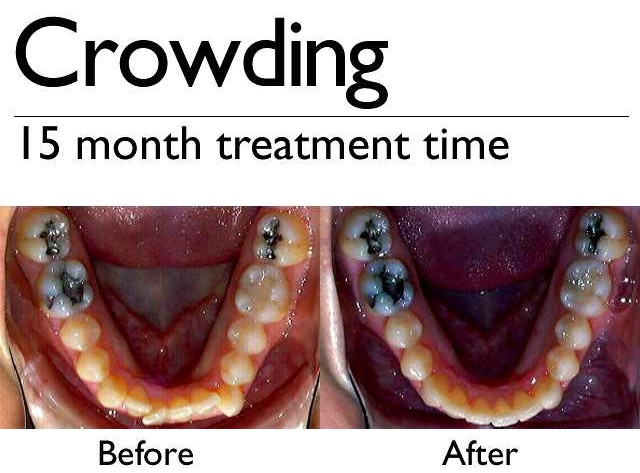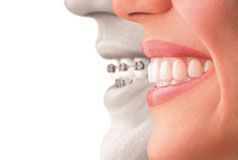 Having beautiful straight teeth can lift your confidence and boost your self-esteem. That’s why there’s no better time than now to transform your smile with Invisalign®.
Having beautiful straight teeth can lift your confidence and boost your self-esteem. That’s why there’s no better time than now to transform your smile with Invisalign®.
Invisalign® is the virtually invisible and hygienic alternative to braces that lets you keep smiling during your treatment. Invisalign uses a series of custom-made, clear, removable aligners that gradually move teeth toward the smile you’ve always wanted. Invisalign is so discreet; most people won’t even notice you’re wearing them. Ask Dr. Susan Leonera-Salazar if Invisalign is right for you.
Before and After Pictures
Frequently Asked Questions
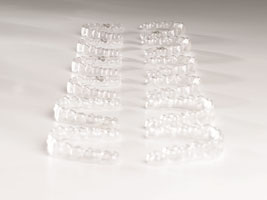 What is the Invisalign® System?
What is the Invisalign® System?Invisalign is the virtually invisible way to straighten teeth without braces. The Invisalign System uses a combination of proprietary virtual modelling software, rapid manufacturing, mass customisation and virtually clear, removable ‘aligners’ to straighten teeth without metal or wires. The Invisalign system is prescribed to patients through trained Invisalign Orthodontists or Dentists, and only they can determine a patient’s suitability and exact treatment plan.
Does Invisalign really work?
Yes. In both clinical research and in orthodontic and dental practices around the world, Invisalign has been proven effective at straightening teeth. Over 1.4 million patients with a wide variety of dental challenges have been treated with Invisalign. Invisalign was developed with orthodontists and is used in more than 50 countries around the world.
Does Invisalign work as well as normal braces?
Invisalign has proven to be as effective at straightening teeth as traditional braces. The level of Invisalign experience will determine how an orthodontist or dentist decides how to treat a patient, be it with Invisalign or traditional braces. Patients with severe crowding or bite problems may require interdisciplinary treatments in which Invisalign is used in combination with other teeth straightening techniques.
How does Invisalign work?
Invisalign uses 3-D computer imaging technology to depict the complete treatment plan from the initial position to the final desired position from which a series of custom-made “aligners” are produced. Each aligner moves teeth incrementally and is worn for about two weeks, then replaced by the next in the series until the final desired position is achieved.
What are the primary benefits of Invisalign?
There are four primary benefits of Invisalign:
- Invisalign is nearly invisible – you can straighten your teeth without anyone knowing.
- Invisalign is removable – you can eat and drink what you want in treatment; you can also brush and floss normally to maintain good oral hygiene.
- Invisalign is comfortable – there are no metal brackets or wires to cause mouth irritation: no
metal or wires also means you spend less time in the doctor’s chair getting adjustments. - Invisalign allows you to view your own virtual treatment plan before you start – so you can see how your straight teeth will look when your treatment is complete.
What are aligners made of?
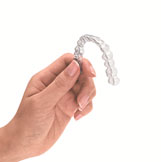 Aligners are made of clear, strong medical grade non-toxic plastic that is virtually invisible when worn.
Aligners are made of clear, strong medical grade non-toxic plastic that is virtually invisible when worn.
What do aligners look like?
Aligners are nearly invisible and look similar to clear tooth-whitening trays, but are custom-made for a better fit to move teeth. Some orthodontists have referred to them as “contact lenses for teeth.”
How long will treatment take?
The length of treatment is dependent on the severity of each individual patient’s orthodontic issues. Treatment may vary from anywhere between six months to two years with an average treatment taking around 12 to 14 months.
Is this a new way to straighten teeth?
For years, orthodontists have used removable appliances for limited treatment. Today, with the application of computer technology and mass-customised manufacturing, Invisalign is able to treat a broader range of orthodontic issues with greater precision.
How old is the company?
Align Technology, Inc., the company that manufactures Invisalign aligners, was founded in 1997. It is listed on the NASDAQ Stock Exchange in the USA (Stock Code: ALGN). Invisalign is distributed and supported in Australia by Invisalign Australia Pty Ltd, an independent distributor.
How old is this technology?
In 1945 an American orthodontist Dr. H.D. Kesling envisioned that one day, modern technology would enable the use of a series of tooth positioners to produce the kinds of movements required
for comprehensive orthodontic treatment. With Invisalign, this is now possible. Using advanced computer technology, Invisalign generates a series of customised “aligners”. Each aligner is worn sequentially by the patient to produce extensive tooth movements in both upper and lower arches.
How many patients are being treated with Invisalign?
Over 1.4 million patients worldwide have been treated with Invisalign and the number grows daily. Invisalign was launched in Australia in February 2002 and already over one thousand Australian orthodontists and dentists have been trained to treat patients with Invisalign.
Do orthodontists and dentists need special training in order to use Invisalign?
While Invisalign can be used with virtually any treatment philosophy, specific training is needed. All orthodontists and dentists interested in treating patients with Invisalign must attend a training course before a patient’s records can be submitted to Align Technology. Our dentist, Dr. Susan Leonera-Salazar, has been trained to treat patients with Invisalign.
How does Invisalign effectively move teeth?
Like brackets and arch wires, the Invisalign aligner moves teeth through the appropriate placement of controlled force on the teeth. The principal difference is that Invisalign not only controls forces, but also controls the timing of the force application. With each aligner, only certain teeth are allowed to move, and these movements are determined by the orthodontic treatment plan for that particular aligner. This results in an efficient force delivery system.
Book an appointment with Q1 Dental Care today for an initial consultation by calling (02)62994822 or emailing contactus@q1dentalcare.com.au.
Have Invisalign conducted clinical tests or studies?
As is typical of medical product introductions, Invisalign conducted extensive testing prior to commercially releasing the product. Various US universities have conducted clinical studies and numerous clinical articles have been published by US and Australian orthodontists.
In most cases, the cost of Invisalign is comparable to the cost of adult ceramic braces. However as with other medical treatments, the cost of treatment is determined by the prescribing orthodontist or dentist and is based upon the complexity of treatment required and the schedule of fees charged. Q1 Dental Care offers flexible and affordable payment plans.
Does insurance cover Invisalign?
If your insurance policy has orthodontic coverage, Invisalign should be covered to a similar extent as conventional braces as Invisalign is normally prescribed for a full course of orthodontic treatment. However, as medical benefits differ significantly from policy to policy, each patient should check with their health fund.
My insurance company has not heard of Invisalign.
Invisalign is an emerging form of technology within orthodontics in Australia. It often takes insurance companies to formally recognise new technologies in their policies. Please consult your treating orthodontist or dentist to ascertain the type of treatment you will be receiving and determine their billing policies in relation to private medical insurance. Invisalign Australia can provide assistance if necessary.
Is there a price reduction if I only require the top/bottom aligner?
The charge for Invisalign is based upon the consultations needed and the 3D modelling cost. Single arch treatment does not mean that the price will necessarily be halved from the two arch treatment cost. Please call us to know more about pricing.
Does Invisalign have a guarantee?
Invisalign is as effective at straightening teeth as traditional methods of orthodontics but largely depends upon a patient’s biology and compliance with treatment. As such, Invisalign cannot guarantee that a patient’s teeth will move exactly as predicted.
The treating orthodontist or dentist is responsible to use their experience and skill to treatment plan and monitor the appropriate treatment as it progresses. If necessary, additional treatment with Invisalign or other forms may be needed. Discuss this further with your dentist during your initial consultation.
Can I claim any rebate on Invisalign treatment?
Yes. There is a government rebate that is available to a taxpayer whose eligible net medical expenses in the year of income exceed $1,500 (net of Medicare and any health fund refund). The amount of the rebate is 20% of the excess over $1,500 but cannot exceed the amount of tax otherwise paid. The rebate is claimed when the patient lodges their annual income tax return.
Invisalign does not treat patients. Orthodontists and dentists do, and with experience they can use Invisalign to treat a vast majority of adults and adolescents who want a better smile. For more information on what types of cases can be treated or to see if your type of dentition is suitable for Invisalign treatment, call Q1 Dental Care today.
How do I know if I’m a candidate for Invisalign?
Align Technology defers to the professional judgment of the treating doctor in determining how Invisalign can be incorporated into the treatment plan. Align Technology almost never rejects the cases submitted by our doctors, as we currently accept over 98% of all cases we receive but only an orthodontist or dentist who has been Invisalign trained can determine if Invisalign is an effective option for you.
What conditions would make me unsuitable for Invisalign?
Only the treating orthodontist or dentist is able to determine whether your particular case is suitable to be treated with Invisalign. Three types of tooth movements have found to be less predictably achieved with Invisalign alone:
- Severe derotations of cylindrical teeth
- Complex extrusions
- Closure of large spaces usually associated with extractions of teeth other than lower incisors
With more Invisalign experience, doctors may improve the ways they manage the treatment and increase the predictability of these movements.
What is the minimum age that Invisalign can treat?
Almost all teenagers over the age of 14 are eligible for treatment with Invisalign as long as their second (twelve year old) molars are fully erupted.
I am currently wearing braces – can I make the switch to the Invisalign?
Many patients are being treated with some form of combination of braces and Invisalign. You should consult your orthodontist or dentist to determine the best treatment for you.
Does the procedure work on overbites (overjets) and how?
Yes, Invisalign can correct mild to moderate overbites. The aligners create a force on the front teeth causing them to intrude, thus correcting the overbite.
Are there certain dental conditions that automatically exclude you from being an eligible patient?
Yes, certain dental conditions can restrict you from being an eligible patient – for further information, please consult your orthodontist or dentist. Cases that are difficult or unsuitable for Invisalign may include up-righting severely tipped teeth, cases where not all the permanent teeth have erupted, cases with multiple missing teeth, patients with poor periodontal condition or patients that want to change their facial profile.
Are crowns a factor in Invisalign treatment?
No, crowns are usually not a factor in Invisalign treatment. However, small composites called attachments are sometimes bonded onto teeth to help achieve certain movements. In these cases, the location of crowns must be carefully evaluated by an Invisalign orthodontist or dentist.
Will TMJ affect Invisalign treatment?
TMJ refers to the temporomandibular, or jaw joint. Individuals can have a number of problems with the jaw joint, some of which can be aggravated by appliances and treatments like Invisalign. To find out if your TMJ problem will adversely impact orthodontic treatment, consult our dentist.
Can Invisalign close gaps (space closure)?
Yes. Spaces between teeth are generally easy to close with Invisalign. However, the size and location of the spaces will need to be evaluated.
Are bridges a factor in Invisalign treatment?
Because bridges firmly link two or more teeth together, they can offer significant resistance to tooth movement. Your orthodontist or dentist will be able to determine whether bridges will be a factor in your treatment.
After or during the initial consultation, your treating dentist will need to take x-rays, photos and moulds of your teeth. These records will be sent to the USA to be used to manufacture your custom made aligners. This process will take approximately 6 weeks (from the time the records are sent to the USA to the time treatment can begin).
How often must I see the dentist?
Your dentist will schedule regular appointments – usually about once every six weeks. This is the only way your dentist can be sure that the treatment is progressing as planned.
Will the treatment be painful?
Most people experience temporary, minor discomfort for a few days at the beginning of each new stage of treatment. This is normal and is typically described as a feeling of pressure. It is a sign that the Invisalign aligners are working — sequentially moving your teeth to their final destination. This discomfort typically goes away a couple of days after you insert the new aligner in the series.
Will wearing the Invisalign aligners affect my speech?
Like all orthodontic treatments, aligners may temporarily affect the speech of some people, and you may have a slight lisp for a day or two. However, as your tongue gets used to having aligners in your mouth, any lisp or minor speech impediment caused by the aligners should disappear.
Are there restrictions on what I can eat while in treatment?
No. Unlike traditional orthodontics, you can usually eat whatever you desire while in treatment because you remove your aligners to eat and drink. Thus, there is no need to restrict your consumption of any of your favourite foods and snacks, unless instructed otherwise by your dentist. Also, it is important that you brush your teeth after each meal and prior to reinserting your aligners to maintain proper hygiene.
Can I drink with aligners still on?
You should remove your aligners to drink anything else except water. Leaving aligners on while drinking may stain them and the patient may risk tooth decay if they drink fluids with sugar in them.
Will smoking stain the aligners?
We discourage smoking while wearing aligners because it is possible for the aligners to become discoloured.
Can I chew gum while wearing aligners?
No, gum will stick to the aligners. We recommend removing your aligners for all meals and snacks.
What’s the best way to clean my aligners?
The best way to clean your aligners is by brushing and rinsing them in lukewarm water. Your treating doctor can also supply you with aligner cleaning crystals.
How often must I wear my aligners?
Aligners should be worn all day, except when eating, brushing and flossing.
Can patients use aligners for bleaching teeth while active tooth movement is occurring?
While we are aware that some patients are using aligners for bleaching, Align Technology, Inc. has not examined the compatibility of currently available bleaching products with our aligners, nor have we demonstrated efficacy in clinical studies. Align recommends that you consult your orthodontist or dentist for more information on whitening teeth.
What happens after treatment to prevent my teeth from moving again?
This depends on the outcome of the treatment. Some patients might need a positioner, or conventional retainer. Other patients might need a clear plastic retainer similar to Invisalign aligners. Discuss these possibilities with your treating dentist. Every patient is different and outcomes vary.
What happens if the aligners no longer fit?
In this case you should contact your dentist immediately who will diagnose what remedial action is needed to bring the treatment back on course. This may involve moving back one or two stages in treatment to a previous aligner or possibly some additional orthodontic treatment.


